Shapes of molecule - Study guides, Revision notes & Summaries
Looking for the best study guides, study notes and summaries about Shapes of molecule? On this page you'll find 766 study documents about Shapes of molecule.
Page 3 out of 766 results
Sort by
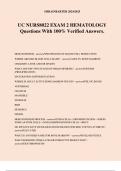
-
UC NURS8022 EXAM 2 HEMATOLOGY Questions With 100% Verified Answers.
- Exam (elaborations) • 20 pages • 2024
-
- £9.35
- + learn more
©BRAINBARTER 2024/2025 UC NURS8022 EXAM 2 HEMATOLOGY Questions With 100% Verified Answers. HEMATOPOIESIS - answerTHE PROCESS OF BLOOD CELL PRODUCTION WHERE ARE RED BLOOD CELLS MADE? - answerADULTS: BONE MARROW CHILDREN: LIVER AND/OR SPLEEN WHAT ARE THE TWO STAGES OF HEMATOPOIESIS? - answerMITOSIS (PROLIFERATION) MATURATION (DIFFERENTIATION) WHERE IS ADULT ACTIVE BONE MARROW FOUND? - answerPELVIC BONES VERTEBRAE CRANIUM MANDIBLE STERNUM RIBS HUMERUS FEMUR HEMATOPOIESIS PROCESS -...
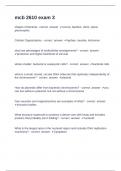
-
mcb 2610 exam 3 Question and answers rated A+ 2024/2025
- Exam (elaborations) • 13 pages • 2024
- Available in package deal
-
- £10.98
- + learn more
mcb 2610 exam 3 Question and answers rated A+ 2024/2025 mcb 2610 exam 3 shapes of bacteria - correct answer coccus, bacillus, vibrio, spiral, pleomorphic Cellular Organizations - correct answer hyphae, mycelia, trichomes what are advantages of multicellular arrangements? - correct answer protection and higher likelihood of survival whats smaller: bacterial or eukaryotic cells? - correct answer bacterial cells what is a small, closed, circular DNA molecule that replicates...

-
AQA A LEVEL Chemistry Questions & Correct Answers/ Graded A+
- Exam (elaborations) • 23 pages • 2024
- Available in package deal
-
- £10.33
- + learn more
Relative atomic mass : The average mass of an atom of an element, relative to 1/12th of the mass of an atom of Carbon-12 Relative molecular mass : Average mass of a molecule compared to 1/12th of the mass of a carbon-12 atom The Avogradro constant : the number of particles in a mole ideal gas equation : pV = nRT empirical formula : the simplest whole number ratio of atoms of each element in a compound 2 percentage atom economy : (Mass of desired product/total mass of reactants) x 1...
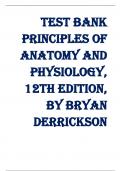
-
Test Bank Principles of Anatomy and Physiology, 12th Edition, by Bryan Derrickson, Gerald Tortora | Complete Guide A+
- Exam (elaborations) • 748 pages • 2023
-
- £14.64
- 1x sold
- + learn more
Test Bank Principles of Anatomy and Physiology, 12th Edition, by Bryan Derrickson, Gerald Tortora Testbank Chapter 1. An Introduction to the Human Body Multiple Choice 1. This is the study of the functions of body structures. a. Anatomy b. Physiology c. Dissection d. Histology e. Immunology Ans: B Difficulty: easy Feedback: 1.1 2. This is defined as a group of cells with similar structure and function. a. Tissue b. Organ c. Molecules d. Compounds e. Organism Ans: A Difficulty: easy Feedback: 1.2...
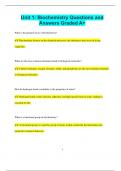
-
Unit 1: Biochemistry Questions and Answers Graded A+
- Exam (elaborations) • 12 pages • 2024
- Available in package deal
-
- £8.13
- + learn more
Unit 1: Biochemistry Questions and Answers Graded A+ What is the primary focus of biochemistry? Biochemistry focuses on the chemical processes and substances that occur in living organisms. What are the most common elements found in biological molecules? Carbon, hydrogen, oxygen, nitrogen, sulfur, and phosphorus are the most common elements in biological molecules. How do hydrogen bonds contribute to the properties of water? Hydrogen bonds create cohesion, adhesion, and high ...

-
BSC1010 FINAL EXAM QUESTIONS AND ANSWERS WITH COMPLETE SOLUTIONS VERIFIED RATED 100% PASS
- Exam (elaborations) • 18 pages • 2024
- Available in package deal
-
- £9.35
- + learn more
BSC1010 FINAL EXAM QUESTIONS AND ANSWERS WITH COMPLETE SOLUTIONS VERIFIED RATED 100% PASS Enzyme Z catalyzes a reaction that transforms a substrate called ZEE into a product called ZED. Enzyme Z is regulated by two different inhibitor molecules called inhibitor W and inhibitor X. The shape of inhibitor W is very similar to the shape of ZEE while the shape of inhibitor X is completely different from ZEE, ZED, or inhibitor W. t inhibitor molecules called inhibitor W and inhibitor X. The shape o...
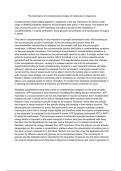
-
25/25 A Level biology essay: the importance of complementary shapes of molecules in organisms
- Essay • 3 pages • 2023
- Available in package deal
-
- £8.48
- + learn more
25/25 A Level biology essay written by a student who achieved A* in Biology at A Level. This essay is a great example of how to integrate beyond the specification content to get into the highest marking bracket.
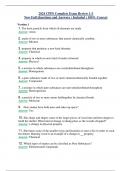
-
2024 CPPS Complete Exam Review 1-3 New Full Questions and Answers ( Included ) 100% Correct
- Exam (elaborations) • 27 pages • 2023
-
- £8.54
- + learn more
2024 CPPS Complete Exam Review 1-3 New Full Questions and Answers ( Included ) 100% Correct Version 1 1. The basic particle from which all elements are made Answer: Atom 2. made of two or more substances that arenot chemically combine Answer: Mixture 3. property that produces a new kind ofmatter Answer: Chemical 4. property in which no new kind of matter isformed Answer: Physical 5. a mixture in which substances are evenlydistributed throughout Answer: Homogenous 6. a pure substan...
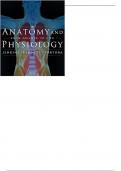
-
Anatomy And Physiology From Science to Life, 2nd Edition by Jenkins, Gail - Test Bank
- Exam (elaborations) • 358 pages • 2023
- Available in package deal
-
- £15.49
- 1x sold
- + learn more
1. Which of the following tissues is always avascular? A) connective tissue D) epithelial tissue B) muscle tissue E) nervous tissue C) skeletal tissue Ans: D Difficulty: Medium 2. A scientist who examines tissue changes that might indicate disease is called a A) histologist. D) epidemologist B) radiologist. E) endocrinologist. C) pathologist. Ans: C Difficulty: Easy 3. The tissue lining body cavities is A) epithelial tissue. D) m...
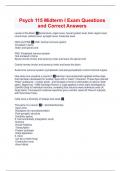
-
Psych 115 Midterm I Exam Questions and Correct Answers
- Exam (elaborations) • 55 pages • 2024
-
- £13.83
- + learn more
Levels of the Brain Social level, organ level, neural system level, brain region level, circuit level, cellular level, synaptic level, molecular level CNS and PNS CNS: Central nervous system Encased in bone Brain and spinal cord PNS: Peripheral nervous system Not encased in bone Spinal nerves (motor and sensory) enter and leave the spinal cord Cranial nerves (motor and sensory) enter and leave the brain. Autonomic nervous system (sympathetic and parasympathetic) control internal organs How ...

£5.50 for your revision notes multiplied by 100 fellow students... Do the math: that's a lot of money! Don't be a thief of your own wallet and start uploading yours now. Discover all about earning on Stuvia


